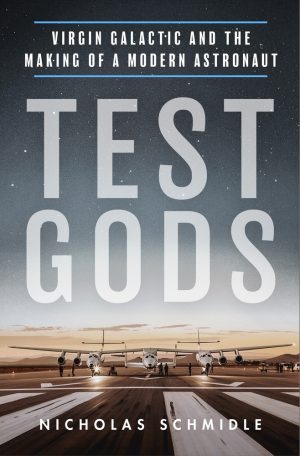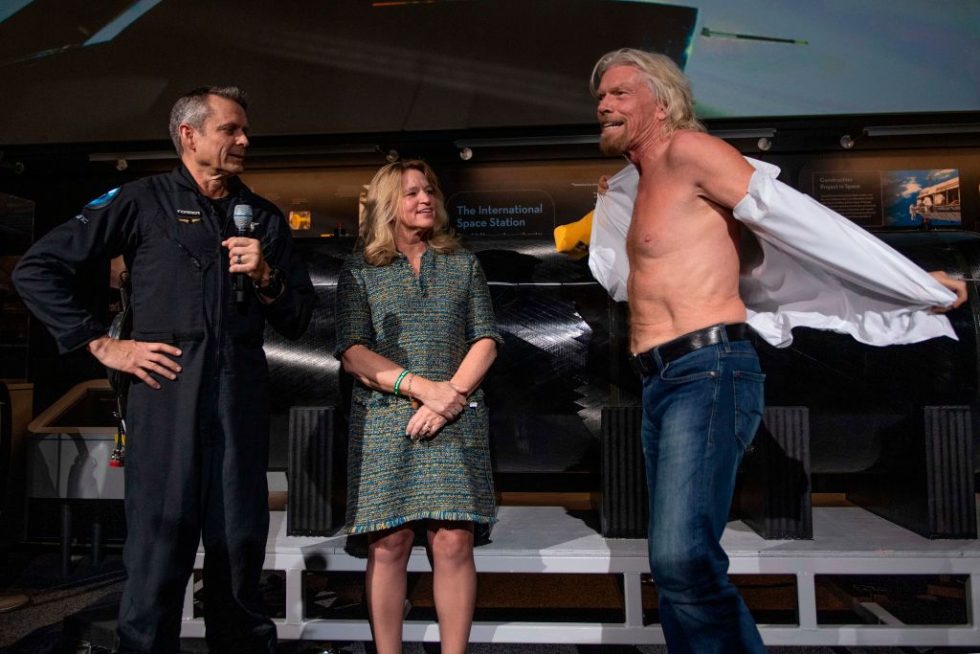-
Virgin Galactic Test Pilot Mark "Forger" Stucky is seen during a ceremony at the National Air and Space Museum in Washington, DC, on February 7, 2019.
-
Here's the view from 82 km above Earth, during the company's first spaceflight in December 2018, piloted by Stucky.
-
Virgin Galactic's SpaceshipTwo takes off for a suborbital test flight of the VSS Unity on December 13, 2018, in Mojave, California.
-
The company flew test missions from Mojave, California. But after its test phase, commercial operations will take place in southern New Mexico.
-
This flight is dramatically recounted in a new book, Test Gods.
-
A look at both the carrier aircraft and VSS Unity spacecraft.
-
VSS Unity burned its engines for 60 seconds during the December 2018 flight.
-
Virgin Galactic's VSS Unity comes in for a landing after its first suborbital test flight.
I have always struggled with what to think about Virgin Galactic, the brilliantly marketed space-tourism company founded by Sir Richard Branson in 2004.
Certainly, Branson founded the company with laudable goals. Bringing more people above the planet to see the curvature of the Earth and experience weightlessness should only help humanity better understand the value of our fragile world. And Branson's infusion of private funding into spaceflight, alongside that of other billionaires, has been an extraordinary boon over the last two decades in terms of pushing humans further into the final frontier.
Yet, Virgin Galactic has always felt like it had a little too much sizzle and not quite enough substance. Here's just one example: after months of buildup, the company finally revealed in July how the interior of its VSS Unity spacecraft would look. However, upon the reveal, the views of the cabin weren't actual photographs. Instead, they were slick renderings.
Then there is the slow pace of development. More than a decade ago, Branson predicted that Virgin Galactic's first spaceflight—via a rocket-powered spaceplane dropped from a large carrier aircraft—would take place by January 2011. He also spoke of developing a space hotel and small spaceships to cruise around the Moon in the 2020s. To its credit, Virgin Galactic did finally reach "space" in December 2018, flying above 80 km. The Unity spacecraft returned three months later with a second flight. It has not been back since, and it has not yet carried any space tourists.
So what, exactly has been going on? A new book by Nicholas Schmidle, Test Gods: Virgin Galactic and the Making of a Modern Astronaut, does an admirable job of telling us the rest of this story. Schmidle works for The New Yorker magazine, so naturally this is a beautifully written book. But it also offers a rich portrait of the company's chief test pilot, Mark "Forger" Stucky, and a complicated company. Published by Henry Holt and Co., the book will go on sale Tuesday, May 4.
Test Gods grew out of a long article Schmidle wrote for The New Yorker on Forger and Virgin Galactic, which was published in 2018. As Schmidle explains, he enjoyed unparalleled access to Virgin Galactic beginning in 2014, shortly after a fatal crash of the VSS Enterprise spacecraft that killed co-pilot Michael Alsbury. (This flight test was operated by Scaled Composites, which developed the spaceship for Virgin Galactic). Few restrictions were placed on Schmidle, and he was allowed to record phone calls and meetings. This lasted for more than four years.
"After the New Yorker piece appeared, in August 2018, my embedded status was revoked," Schmidle writes in the book. "(Michael) Moses instructed employees that I was no longer embedded and to cease speaking with me."
While he was there, Schmidle had a front-row seat to some of the most pivotal years of Virgin Galactic, including the aftermath of the Enterprise crash and the hazard-filled development of Unity. His story focuses mostly on Forger, a compelling but flawed character who is a wizard in flight but struggles in relationships with his children. Forger ultimately served as the pilot of the first Unity flight above 80 km in 2018, and he received his astronaut wings. We share his triumph in Test Gods.
Portraits of other key players at Virgin Galactic also emerge. Branson—in contrast to other space-age billionaires such as Elon Musk and Jeff Bezos, who dig into the engineering details of their rocket companies—is somewhat detached and focused solely on marketing.
Michael Moses, who came to Virgin from NASA's space shuttle program and serves as president of space missions and safety, is portrayed as a pivotal employee diligently trying to move the ball forward. There's a great detail in the book when Moses and his wife, Beth—Virgin's chief astronaut instructor, who herself would ride to space on the second flight in February 2019—are discussing the rivalry between Virgin Galactic and Blue Origin. "I'd buy a ticket with Blue," she says.
Others in the book are less favorably described. George Whitesides, the long-time chief executive who left Virgin Galactic earlier this year, comes across as indecisive. "It's hard to make decisions around here sometimes," Michael Moses says at one point in the book in clear reference to Whitesides. "Sorry. It's hard to get other people to make decisions sometimes. I don't have too much of a problem."
The company's "chief customer officer," Stephen Attenborough, is portrayed as vindictive. Attenborough has the difficult job of convincing customers, some of whom have been signed up with the company for $250,000 spaceflights for more than a decade, to keep their reservations for uncertain future flight dates.
Perhaps most importantly, primarily through Stucky's eyes, we get a sense of the precariousness of Virgin Galactic's spaceflight technology. Unlike Blue Origin's automated New Shepard launch system or SpaceX's Crew Dragon Vehicle—which can take off from Earth and dock to the International Space Station in low Earth orbit without an astronaut ever touching the controls—VSS Unity is very much an analog system.
After its second spaceflight in February 2019, Virgin Galactic said it was pausing space operations for a time to retrofit the vehicle for commercial flights with space tourists. This seems to be only partly true. Schmidle reports that, when members of the flight crew wheeled Unity into the hangar after this second spaceflight, they found a wide gap had opened up in the structure of the space plane. "It looked like someone ripped the caulking out of a bathtub," Stucky said. Some safety employees at the company were mortified and felt very fortunate that no one had died on that flight.
All of this is not to say Schmidle found any nefarious goings-on in his deep reporting on Virgin Galactic. It is to the company's credit, and to that of Branson, Whitesides, and others, that they allowed a journalist this kind of access. But inevitably in rocket development programs, there are tensions between the willingness of test pilots to take risks and aerospace engineers who want more time to design and test. In Virgin's case, this is compounded by a marketing team that has been selling tickets to space for 15 years, while the company has yet to fly a paying customer and is desperate to deliver. Recently, too, there has been the need to mollify shareholders of the publicly traded company.
What Schmidle learned makes for high drama. Rarely do outsiders get such an insider's perspective on all of this, and in this way Test Gods is revelatory.
Alas, we still do not know whether Virgin Galactic will ultimately succeed in taking thousands of people to space. The sense one gets from Stucky, through Schmidle's telling, is that every flight of VSS Unity requires an immense amount of focus and that peril is always around the corner. This image of Virgin Galactic is clearly at odds with the slick presentation of the company in its promotional materials and the promises to stockholders of hundreds of flights per year to reach profitability. Time will tell which story has the right of it.
Listing image by Henry Holt and Co.
reader comments
178